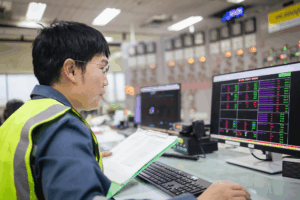
Building a connection between mental health and safety in the construction industry
According to the U.S. Bureau of Labor Statistics, almost 20% of all workplace deaths in 2023 occurred within the construction industry, making it one of the most dangerous jobs in the United States. The inherent physical risk factors associated with construction, such as falling and using dangerous equipment, along with irregular hours and transient work sites, lead to high work-related stress as well as a lack of connection.
As a result, many construction workers may experience depression, anxiety, and other psychological effects. But how do these mental health issues relate back to safety, specifically in the construction industry?
Redefining “safety”
The U.S. Surgeon General’s framework for workplace mental health and well-being consists of five elements:
- Protection from harm
- Connection and community
- Work-life harmony
- Mattering at work
- Opportunity for growth
First, among these essential components, “protection from harm,” encourages companies and organizations to rethink their definition of safety. The framework states explicitly that all employees deserve to be protected not only from physical harm in the workplace but from mental and emotional harm, as well.
Research from the Centers for Disease Control and Prevention (CDC) shows that negative psychosocial factors, such as a lack of support from managers and unrealistic job demands, lead to negative health impacts, including poor safety outcomes. A body under stress is more injury-prone, more fatigued, and more susceptible to mental health disorders and substance abuse. On the other hand, when a worker feels physically and psychologically safe at work, their productivity increases while their mistakes and injuries decrease. In a dangerous profession like construction, this correlation between protection from harm and positive safety outcomes becomes especially significant.
Fatalities in construction
Though many hazards exist in construction, there are four that account for most fatal injuries:
- Falls to the lower level
- Struck-by
- Electrocutions
- Caught in or between
Unfortunately, these Focus Four and other fatal at-work injuries don’t account for all construction deaths. Instead, in 2023, the CDC reported 15,900 deaths by overdose and 5,100 deaths by suicide. Many construction deaths by overdose result from an attempt to control chronic pain with opioids, which can lead to addiction.
The most tragic effect of ignoring mental health in construction is the high number of deaths by suicide among industry workers. Only mining has a higher rate of suicide than construction, according to a recent study published by the U.S. Department of Health and Human Services. The study found a suicide rate of 56 out of 100,000 for male construction workers and 10.4 out of 100,000 for females, compared to 32 and 8, respectively, in the general working population.
Substance abuse contributes to suicidal ideation, further connecting the two categories of construction fatalities. These shocking numbers signal an ongoing need for a cultural shift in construction workplace safety, one that emphasizes the mental health and well-being of workers.
Next steps
Many industry organizations are acknowledging the connection between mental health and safety in construction through various initiatives and lobbying efforts. For example, the Construction Industry Alliance for Suicide Prevention offers many resources on its website, including a Needs Analysis and Implementation Tool.
The Occupational Safety and Health Administration (OSHA) also recognizes the role of psychosocial factors in safety outcomes by annually highlighting Construction Suicide Prevention Week in September. Additionally, the agency runs a construction suicide prevention hotline.
In January 2025, a new OSHA standard for personal protective equipment (PPE) in construction went into effect. Studies have shown a link between properly fitting PPE and worker well-being. With the new OSHA criteria, construction workers may experience renewed attention to their physical safety and, hopefully, their mental and emotional safety, too.
Better mental health, better safety outcomes
In a hazard-ridden profession like construction, establishing a healthy and open workplace safety culture helps to reduce at-work injuries and fatalities not only through regulatory compliance but also through a philosophy – and ideally procedures – related to mental health. A construction worker who feels valued, supported, and safe is a construction worker who makes fewer mistakes, reduces their rate of injury, and helps to decrease the high rate of substance abuse and suicide industry-wide.



